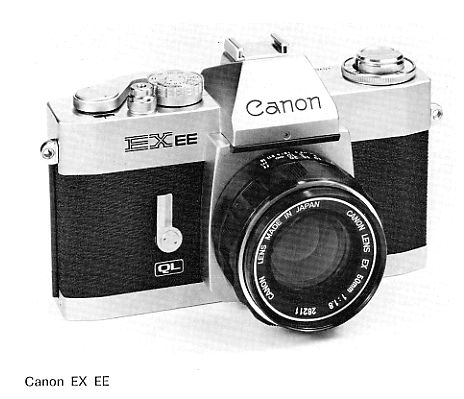

Canon EX EE Camera
All the advanced characteristics of the Canon single-lens reflex system can be found in this camera, such as a through-the-lens metering system, QL (quick loading) system, lens interchangeability (though this is limited), and others. Let us first examine lens interchangeability, which is somewhat different from the system used with other Canon SLR cameras. Three lenses are available for this camera: the 35mm f/3.5 wide-angle lens, the 50mm f/l.8 normal lens, and the 95mm f/3.5 telephoto lens. Lens interchangeability, though limited, is nevertheless unique. To change to a different focal length only the front component of the lens has to be changed, while the rear component, which is common for all the three focal-length lenses, along with the diaphragm, remains in the camera body. This solution has to be used in order to enable the electric-eye system to adjust the diaphragm automatically.
Now let us see how the metering system works. First we have to set the film speed on the shutter-speed dial by lifting up the outer ring and turning it until the desired film speed is in line with the index mark. There are, however, two index marks on the Canon EX EE camera. One, when the normal lens is used, whose maxi�mum aperture is f/1.8, and the other, when the wide-angle or tele�photo lens is used, at f/3.5, the largest aperture of both of these lenses. Set the film speed in line with the figure that is the largest aperture of the lens presently in the camera, f/1.8 with the 50mm lens and f/3.5 with the other two lenses.

The measuring system of the camera uses the shutter-speed priority method. First adjust the shutter speed by turning the shutter-speed dial to the desired speed number. After the desired shutter speed is set, turn the aperture-control ring, which surrounds the film-rewind crank, to the EE mark. When the EE is in line with the mark, the CdS photocell is permanently switched on, and the metering system permanently keeps tab on the correct exposure by selecting the correct f/stop instantly and continuously wherever the camera is pointed. Since the selection of the light meter is transmitted to the closing mechanism of the diaphragm, the diaphragm closes automatically to that preselected f/stop number at the same instant as the shutter-release button is depressed. Actually, the shutter-release button activates the diaphragm-closing mechanism. You can actually see in the viewfinder the actual f/stop number that is selected by the light meter, which enables you constantly to see whether the f/stop is in the proper exposure range. If the indicator is pointing toward the overexposure warning mark or toward the underexposure warning mark, the shutter-speed dial has to be readjusted. In case you do not want to make use of the automatic exposure control, you have to rotate the aperture-control ring around the film-rewind crank until the indicator in the viewfinder points to that f/stop number you want to use. The CdS photocell measures the light of the total picture area, giving an average reading, but laying somewhat more emphasis upon the central section of the picture area.
When changing the lens, make sure that the infinity mark of the distance scale for the standard lens, which is on that part of the lens mount that remains in the camera body, is set at the orange-line indicator; this is the focusing ring of the normal lens. To focus the lens simply rotate the focusing ring until you see the image correctly focused in the viewfinder. But when another focal-length lens is attached to the camera (to the rear element of the lens system) its own distance scale has to be adjusted properly.
To do this, rotate the distance scale of the front component of the particular lens until the infinity mark of the distance scale lines up with the white index of the focusing ring, while the infinity mark of the original focusing ring, which remains in the camera, is in line with the orange index.
After the focusing mechanism has been correctly adjusted, you can focus the lens by turning the focusing ring. You can read the distances on the front component with the white index.
While focusing the lens, make sure not to turn the adjusted distance scale on the front component of the lens.
All the other features of the Canon EX EE camera are identical with the other Canon SLR cameras, except opening the back. To do this with the other Canon SLR cameras, you have to rotate the opening key at the bottom of the camera body.
The Canon EX EE simplifies this procedure, since the camera back pops open when the film-rewind crank is pulled out completely. When the film is properly loaded into the camera, just press the camera back and it snaps closed.
Back - Previous page - Next page
� Christian Rollinger 2002